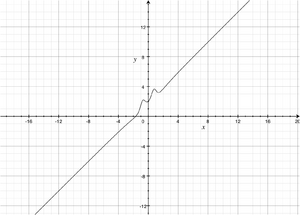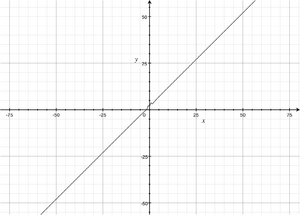Course:MATH110/Archive/2010-2011/003/Notes/Asymptotes
Asymptotic Behaviour




We say that a function is asymptotically equivalent to another function if they are almost the same as we zoom out. There are multiple ways this can happen, we'll concentrate on one specific case which is when we can write that:
Where is a function such that:
- .
There are many ways to think of this, one is to say that the function measures the difference between the functions and . For values of that are not to big, the function might create quite a big difference between the functions and , but as tends to infinity (on either side that you're interested in), it becomes smaller and smaller, showing us on the long run that the functions are getting more and more similar.
| Example |
|---|
|
On the right side of this page, you can see plots of the function: As you can see, as we zoom out, we start to notice that function looks more like a linear function than what we could have thought in the beginning. Rewriting the function as in the second equality allows us to see it written in the format with Since we can clearly see that This shows that the function is asymptotically equivalent to the linear function . It is important to keep in mind it doesn't mean that the function necessarily becomes exactly this line at some point. Instead, it tends towards it more closely as we keep zooming out. |
Horizontal Asymptotes
When a function is asymptotically equivalent to a constant function, we say that the function has a horizontal asymptote. Recall that constant functions are those of the form:
So, for a function to have a horizontal asymptote means that:
- where
This has two implications.
- First visually, this means that the function tends to a horizontal line as you zoom out.
- Second algebraically, we can actually see that this implies directly that the function has a limit at infinity which is the constant.
- In other words:
So each time you computed a limit at infinity and found that the limit existed and was a finite number it means that you actually showed that the function you were working with has a horizontal asymptote at or more graphically, that the more you zoom out, the more your curve looks like the line .
Slant Asymptotes
When a function is asymptotically equivalent to a linear function, we say that the function has a slant asymptote.


















